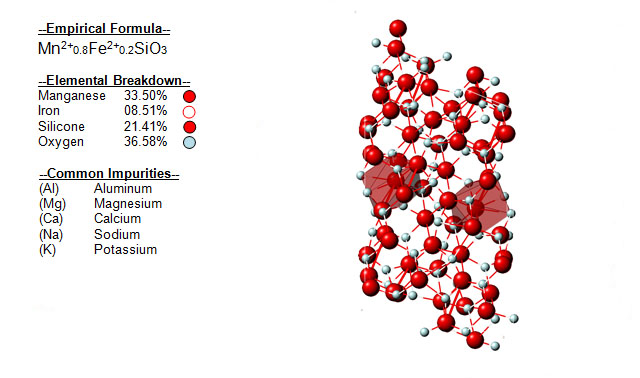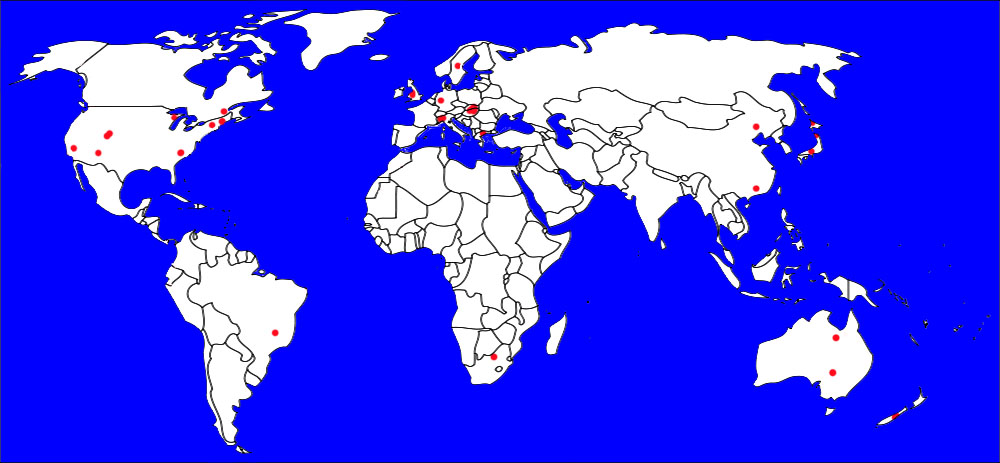

| Mineral Name | Pyroxmangite |
| First Discovered | 1792 |
| Nickel-Strunz Classification | 09.DO.05 |
| Dana Classification | 65.06.01.01 |
| ICSD | 34159 |
| Mineral Group | Silicates |

| Cleavage | Perfect |
| Colour(s) | Pink, Rose pink, Purplish pink, Yellowish red brown, Brown. |
| Specific Gravity | 3.80 |
| Diaphaneity | Transparent to translucent |
| Fracture | Uneven |
| Mohs Hardness | 5.5 to 6.0 |
| Luminescence | |
| Luster | Vitreous - Pearly |
| Streak | White |
| Habit(s) | Massive to Granular |
| Radioactivity | Non-radioactive |
| Magnetism | Magnetic after heating |

No known health risks have been associated with pyroxmangite. However ingestion of pyroxmangite, as with other naturally occurring minerals, is not recommended.

The following image shows the elemental breakdown of the mineral pyroxmangite along with the mineral crystal structure.


| Crystal System | Triclinic | |
| Class | Pinacoidal | |
| Axial Ratios | a : b : c = 0.8886 : 1 : 2.298 | |
| Morphology | Crystals commonly tabular on; porphyroblastic; granular massive. | |
| Optical Data Type | Biaxial (+) | |
| RL Values | nα = 1.726 - 1.748 nβ = 1.728 - 1.750 nγ = 1.744 - 1.764 | |
| 2V | Measured: 35° to 46°, Calculated: 40° to 42° |  |
| Max Birefringence | δ = 0.018 (See colour chart at right) | |
| Surface Relief | High | |
| Dispersion | r > v moderate | |

Pyroxmangite can be referenced in certain current and historical texts under the following one name::
The mineral pyroxmangite can be translated into the following select languages:
| Arabic | Bulgarian | Chinese (Sim) | 三斜锰辉石 | ||
| Croatian | Czech | Danish | |||
| Dutch | Esperanto | Estonian | |||
| Finnish | French | German | Pyroxmangit | ||
| Greek | Hebrew | Hungarian | |||
| Italian | Japanese | パイロクスマンガン石 | Korean | ||
| Latin | Lithuanian | Norwegian | |||
| Persian | Polish | Portuguese | |||
| Romanian | Russian | Пироксмангит | Slovak | ||
| Spanish | Piroxmangita | Swedish | Tagalog | ||
| Turkish | Ukrainian | Vietnamese |

Pyroxmangite can be found in only a very limited number of places around the world. The map below shows major documented concentrations of pyroxmangite:


 |
The MIROFOSS database offers free printable geological identification tags for personal and non-profit use. These tags can be used to properly identify mineral samples in your collection. -Click here- to download a full size jpeg image for a pyroxmangite identification tag; which can be printed on paper or used with a plastic laser printer. |
 |
What's this? What can I do with it? |

| Chemical Composition | Ohashi, Y. and Finger, L.W. (1975) Pyroxenoids. A comparison of refined structures of rhodonite and pyroxmangite. Carnegie Institution Washington Year Book: 74: 564-569. |
| Crystallography | Maresch, W.V. and Mottana, A. (1976) The pyroxmangite-rhodonite transformation for the MnSiO3 composition. Contributions to Mineralogy and Petrology: 55: 69-79. |
| Optical Data | Narita, H., Koto, K., and Morimoto, N. (1977) The crystal structures of MnSiO3 polymorphs (rhodonite- and pyroxmangite-type). Mineralogical Journal of Sapporo: 8: 329-342. |
| History | American Mineralogist (1988): 73: 798-808. |
| History | Deer, W.A., Howie, R.A. & Zussman, J. (1978) Rock-forming Minerals, 2nd. Edition: 2A: 600-613. |
| History | Ford, W.E. and Bradley, W.M. (1913) Pyroxmangite, a new member of the pyroxene group and its alteration product, skemmatite. American Journal of Science: 36: 169-174 (now identified as pyroxferroite). |
| Geographical Data | Mindat.org. Retrieved on 2014-02-10 |
| Physical Identification | Webmineral.com. Retrieved on 2014-02-10 |
| February 10, 2014 | The last time this page was updated |
| ©2017 MIROFOSS™ Foundation | |
 |